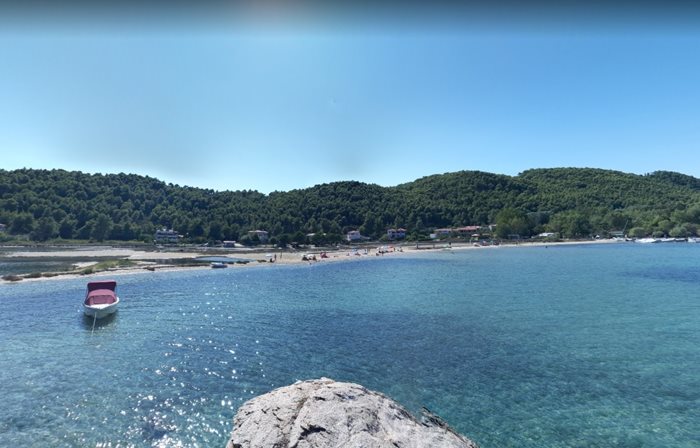While you leave Nikiti, moving easterly, paying much attention during the summer months, you will meet, at 2,3 km to Nikiti’s traffic lights, a central, sufficiently signalled crossroads, just where «Sithon» factory is, which packages the amazing honey of the region. In the crossroads you turn right (southerly) and begin to descend the central street. You have already passed the gate of Sithonia. The peninsula is known to the travellers as «second leg» but in greek mythology could also be said «bad father-in-law». And that’s because it took its name from Sithonas, an unlucky king of Thrace, who, however, came from Chalkidiki. Old Sithonas, presenting rather intense symptoms of Oedipus complex, did not want in any case marry his daughter, thus getting rid of every fiancé. Today Sithonia is one of the most popular tourist destinations in Greece and hides – from the Sithona’s years- the most exotic beaches of Aegean Sea in its coasts . Snow-white sandy beaches, splendid aquamarine shallow and hot waters, dense pinewoods and sleek rocks, give Sithonia a caribbean atmosphere.
At 2,1 km from the central crossroads you will see a small road to your right (westwards), which leads to the small settlement called «
Kastri». The marvellous
sandy beach of Saint Ioannis exists next to Kastri and its villas
.


You continue southerly to the central street and precisely 3 km after the sandy beach of Sait Ioannis, you will see the amazing beach of «Kalogria» with the fine white sand and the pines that reach the waves. Just below «Kalogria» there is the quiet –not in the summertime- small beach «Spathies» and 900 metres below, you will see on your right a small road parallel to the central one. The region, as much as the sandy beach, is named «Elia».
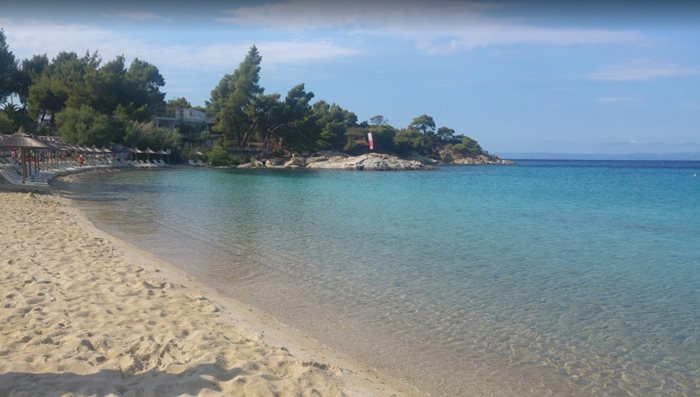
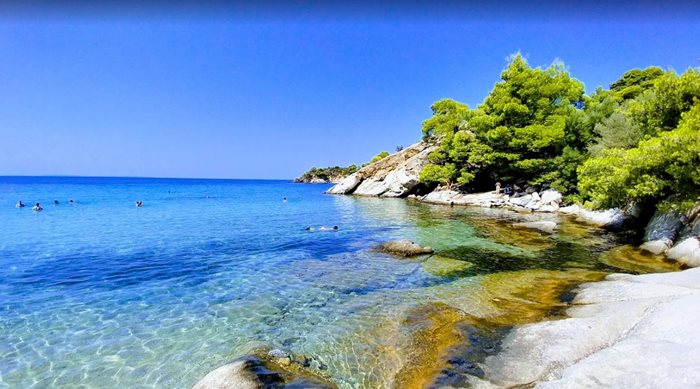

4 km after «Elia» you find yourself in the very beautiful
sandy beach of «Lagomandra», where the pinewoods reach by the sea. A little below, a beautiful valley, full of plane-trees and small aspens, leads to the wide snow-white
sandy beach of «Tripotamos». You continue southerly, through beautiful landscapes with pines and sandy beaches and as you leave the forest of pines you enter a forest of blocks of flats, that welcome you to
New Marmaras.
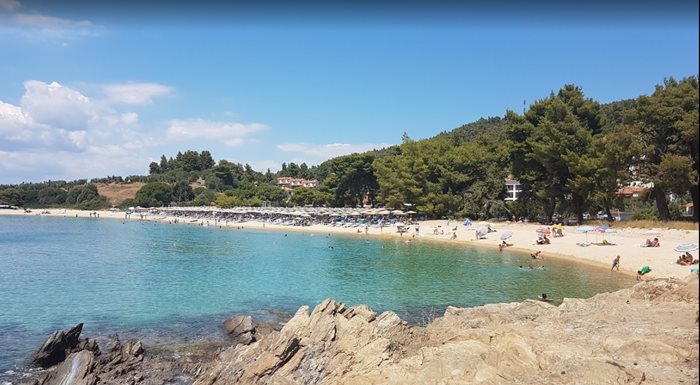
The small but exceptionally safe bight that you will see was once called
«Mpalampani» and should have been very important to the Byzantines, as they fortified it with walls and towers. The place was very important, however, and for the Mount Athos monks, who exploited its rich olive groves. «Mpalampani» before 1429 belonged to the Abbey of Grigorios, where injured Macedonias found shelter during the macedonian fight. In the beginning of the 20th century a small fisherman’s settlement existed in «Mpalampani» which was transformed after 1922 in a big village, where tired refugees from the coasts of Marmaras at Propontida were installed. These tortured persons named the old «Mpalampani» «New Marmaras», in order to remember their lost homeland. The refugees of New Marmaras were finally rooted to the beautiful bight of Sithonia, but never made a fortune as farmers, since they accomplished to well exploit the natural beauties of their new homeland. In the decade of ‘70’s, New Marmaras became one of the most cosmopolitan resorts in Greece.
In a small creek, embelished with splendid pinewoods, was created the biggest –for years- group of organised vacations in Greece, called
«Porto Carras». The huge hotel resort lies today in an extend of 17630 acres and possesses a 10 km beach in front of it. Porto Carras is constituted by two big hotel units, «Meliton» and «Sithonia», and a smaller one called «Village in». Overall, the three units allocate 1815 beds and also commercial centres, taverns and restaurants, a golf course, cellars and vineyards, a casino, a marina of 200 places, a marine club that organises international sailing championships, a sailing and diving school and many more possibilities for sports, marine or not.
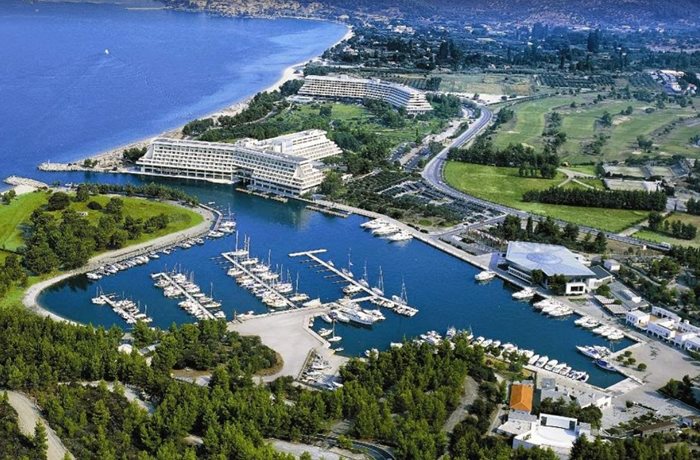
If you choose to stay in New Marmaras, you will have no problem in finding lodging. However such a thing is impossible during August time without reservation.
Following the street that passes through the village, you will meet the beautiful
sandy beach of New Marmaras, just after the central street where you will turn right (southerly). On the other hand, if you miss mountains and adventure, you can turn left (north) in the central street, turn a little bit backwards and precisely 2 km later, you can turn right to the street that leads to
the traditional village of «Parthenonas».

Leaving New Marmaras, you follow the cool –from the dense shade of pines- street and in the following 2,7 km, having already passed from the Porto Carras hotel resort, you will see on your right a small tarmac street that leads coastwise to Toronis gulf and to a pile of amazing beaches. Continuing straight on in the central street, you see, on your left, the beautiful vineyards in the slope of the mountain called Melitonas. Greek and French varieties of grapes are cultivated in the area, giving exceptional wines. A dense net of dirt roads exists among the vineyards, through which you can climb up to the astonishing mountainous landscapes of Sithonia and if the road’s condition allows it, you will finally reach Sarti. 16 km precisely after New Marmaras, you will find a narrow tarmac street on your right, where the sign says “Tristinika-Aretes Beach”. You can make an interesting bypass here, which will drive you back to New Marmaras, revealing the most isolated beaches of Sithonia to you.
.png?lang=en-GB)
The narrow tarmac street descends in the Tristinika’s gulf, where you meet an immense sandy beach that reminds you of how the rest of Sithonia’s coasts were once. However, you will find the most beautiful sandy beach after turning left (southerly) to a dirt road, following the signs “Dimitris tavern” and “Ethnic”. At 1,5 km after the turn to Tristinika’s Beach, you turn left in a dirt road and you reach the splendid sandy beach “Aretes”. If you continue north to the central dirt road, you will meet some of the most beautiful and most isolated sandy beaches of Sithonia. It is a line of lee, small bights with emerald, crystal waters, white sand and very few visitors. The third beach in line is called “Azapiko”. Continue north-westerly, the street has already become tarmac, continuously passing through beautiful, isolated sandy beaches full of marshes and stubbles, and you reach the small bight called “Vathi”. If you turn left (southerly), the street leads to a sandy beach among olive groves and a few pines. The place is called “Diaporti”. It is a sandy “sole”, which, when not covered with water, allows you to go on foot to the small peninsula-island called “Pounta”. However, if you continue north-westerly, you enjoy a beautiful view of the picturesque rocky islands “Spalathonisia”, driving through beautiful pinewoods and olive groves. The tarmac street, passing through a dense pinewood, leads to the central street of Sithonia, just above the Porto Carras bight.
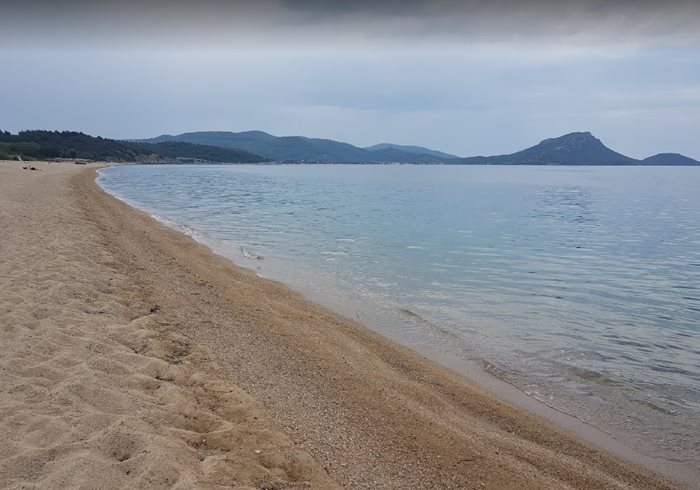
You continue your drive after Tristinika, you turn right (southerly) towards Toroni, leaving behind you two small but beautiful sandy beaches with aquamarine waters, that are found next to “Korakas cape” and you find yourself in the small holiday resort of Toroni. The settlement’s houses –most of them rooms for rent and villas- are stretched out at the length of its marvelous beach. Ancient Toroni was one of the biggest and richest cities of Chalkidiki, which imported beautiful ceramics from southern Greece. From the ancient city you can see today a part of its walls and, if you climb up to its arid slope, relics of its citadel.

You return to the central street of Chalkidiki, you continue southerly and barely 800 meters from the exit to ancient Toroni you turn right to Porto Koufo. You have the best picture of this port on your way back, as you descend to Porto Koufo, coming from east. The spectacle is unique: huge rocks are raised above a gulf, which looks like a lake, since its very small opening to the open sea is hardly distinguished. Porto Koufo was the ancient Toroni’s port, a safe anchorage for the Toronian’s ships. The port was named “Kofos Port” (Deaf Port), because the ancients believed that nobody inside the gulf could hear the murmur of the sea, as he was a deaf man. Nowadays Porto Koufo preserves not only its ancient name, but also its ancient characteristic of the safest and biggest natural port of northern Greece, almost always full of all kinds of recreation crafts. Porto Koufo is a small, quiet fisherman’s settlement, barely influenced by the tourism. Its small port smells like fresh fish, which the sea-food restaurants’ cuisine honors to its fanatic friends.

Leaving Porto Koufo, the central street begins to climb up south-easterly through low hills with wild rocks, while a few bushes, hollies and thyme are the region’s only vegetation. This rocky place extends up to the end of the peninsula of Sithonia, in a steep and wild coast that the locals call “Kartalia”, meaning harrier eagles, since at the scarps of the cape is where some of these proud birds still live. At 3,8 km from Porto Koufo, you will see a dirt road on your right (easterly), which descends to the isolated beach “Ampelos”, an impressive place, where a narrow “tongue” of sea enters in the abrupt slopes of the mountain.
You continue to the central street and 7,5 km later you reach “Kalamitsi”. Kalamitsi is a quiet hamlet with a few rented rooms, two or three taverns and an astonishing beach with white –sugar fine- sand and beautifully shaped grey rocks all around. Leaving Kalamitsi, continuing through the same deserted rocky landscapes at about 3,3 km, you will see a tarmac street to your right (north-easterly). This street leads to the splendid sandy beach “Kriaritsi” from where you can see the beautiful “Skepes”, “Achinoi” and “Petalida” islets. If you leave the central street, directing to Kriaritsi, you might get a little bit tired at the beginning, because of a small labyrinth of roads, relics of a giant settlement’s construction effort, that soon failed, as the most essential –the water supply- hadn’t been foreseen.

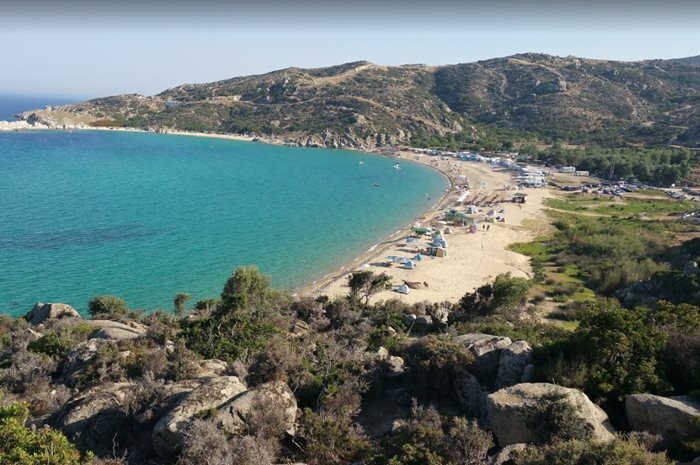
At 1,7km from the central street you will see a dirt road turning left to the quiet
beach “
Klimataria”. Continuing to the central street, in 2,1 km you will reach the crossroads to “
Skala Sikias”, where you will turn right (easterly). After 600 meters you will reach the sandy beach of “Sikia” with its well-done stone built windmills of the 19
th century. Passing the northern edge of the beach, the street continues to the next small
sandy beach “
Valti” and, passing through the next small sandy beach, the street continues and meets the central street of Chalkidiki. In the southern edge of Sikia beach, the street continues and leads to two small sandy bights with nice taverns.


You return to the central street and you go to “
Sikia”, one of the most beautiful and old villages of Sithonia. The first picture, entering in the village, may not be so beautiful, but, continuing to the centre, you will see beautiful, small, narrow paths and old but well preserved houses with yards and terraces, where the grand mothers discuss and the children play free. You leave the beautiful village of Sikia, enjoying the beautiful landscapes around a stream, full of aspens and plane trees and you reach “
Sarti”. Leaving Sarti and continuing north, always following the central street, you pass through the small
sandy beach of “
Achlada”, where a safe small fish-port exists. Continuing north at about 8 km to the beach “Armenisti”, you will pass through a dense pinewood, the eastern part of which is full of countless but short dirt roads, which lead to some of the most exotic beaches of the entire Chalkidiki. One of the most famous is the beach “
Kavourotripes” a lace of small, snow-white sandy beaches, emerald waters, rocks sculptured by the sea and dense pines that reach up to the waves. Driving over Kavourotripes, you enjoy the view to a beautiful valley that leads to an astonishing sandy beach. The aquamarine waters, the rocks emerging round the cape, the crown of Athonas that dominates in the horizon, they all give a very exotic tone to the famous
beach of “Armenisti”.
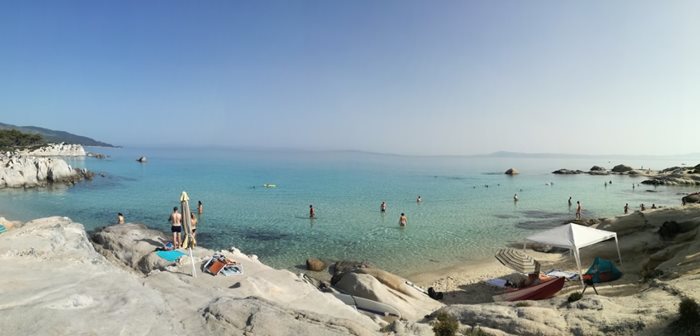

After Armenisti, the street climbs up with smooth turns, full of plane trees, pines and bushes, offering a marvelous view to the gulf and the peninsula of Athonas. After 6,7 km you reach the crossroads to the “
Zografos”
beach. The region once was under the dependency of the homonym Mont Athos monastery.
After an 1,1 km drive in the central street you reach the sandy
beach “
Koutloumousi” –another monastery dependency- where you cannot descend.
After Koutloumousi beach, the street will soon bring you to the famous “
Vourvourou”. In Vourvourou’s region the dominant ancient city “
Siggos”once existed, which gave its name to the gulf between Sithonia and the Athonas peninsula, thus called “Siggitikos”. Leaving the settlement, northwards, you will see Vourvourou’s sandy beach and, of course, the best of all “
Karidi”
beach.

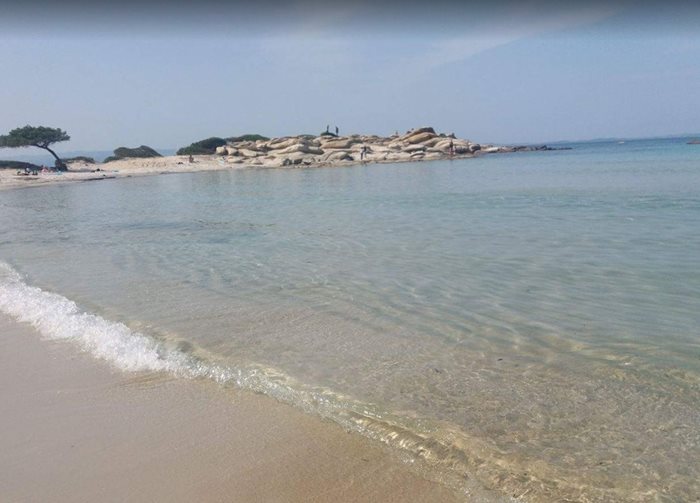
The real paradise is found opposite Vourvourou: the completely
exotic “
Diaporos”
islet and the small archipelago of rocky islets around it. The emerald waters of 5 meters depth between the coast and the islet, in combination with the almost always serene sea, the vegetation and the solitary sandy beaches of the islet, surely reminds you of a Caribbean scene photo. You need a boat, of course, to reach the place.

You continue north to the central street and 2 km after the north Vourvourou’s exit, there is a dirt road on your right (easterly) that leads to the end of a small bight. In its southern part you will see “Livari”, a big sandy sole with cute little pines, making a laguna. Return to the central street and soon you reach the bight of Virgin Mary with a nice sandy beach. However, in order to see the most beautiful sandy beaches of the region, you should turn right in the narrow tarmac street that leads to the Tower. 2 km later you will reach the immense sandy beach “Trani Ammos” and the smaller ones “Pirgos” and “Livrechio”. Passing Virgin Mary’s bight, you continue in the central street and 1,1 km later you meet the street that drives you back to New Marmaras.
